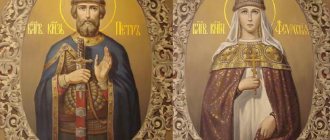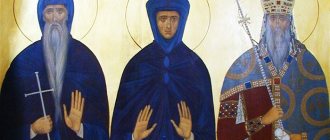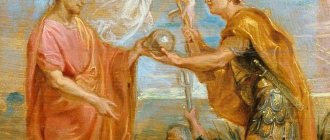Queen Helena is known to us from history as a saint by God's providence who found the cross on which Jesus Christ was crucified. They found it through her prayers and the prayers of Patriarch Macarius in Jerusalem. Queen Helena was sent to Jerusalem by the Emperor of the Roman Empire, her son Constantine. By order of Constantine, the First Ecumenical Council was convened. The Council compiled the Creed, which proclaimed once and for all the divine essence of Jesus Christ, who atoned for the sins of the human race at the cost of his crucifixion. The honorable cross on which Christ was crucified, the main Christian relic, was returned to the world by St. Elena and her son Konstantin.
Who was Queen Helen? What do we know about her life?
- Drepana was born in Turkey.
- She was the daughter of a hotel owner.
- She was married for love to the Roman warrior Constantius Chlorus.
- The couple had a son, Konstantin. This happened in 274. They were happily married for more than 18 years.
- Her husband was then appointed ruler of Galia, Britain and Spain.
- For such a generous gift, Emperor Diocletian demanded that he divorce his wife and marry the emperor's stepdaughter Theodora.
- At the age of 11, Elena’s son was taken away as a hostage of Constantius’s friendship with the emperor.
- Christian teaching becomes a joy and consolation for her. It was only when her son was proclaimed emperor that she was able to unite with him. The son loved his mother so much that he gave her the title of queen.
- Elena did not need power and honors. But she understood that her royal position would give her the opportunity to help spread the Christian gospel.
Helena raised her son, the future Roman emperor, with respect and love for Christianity. His peers, young men of wealthy families, despised Christianity and were brought up in the pagan faith.
The fruits of Elena's upbringing of her son were worthy. Issued by Emperor Constantine in 315, the Edict of Milan gave Christianity the status of state religion for the first time in the Roman Empire. Since then, Christians in Rome were no longer persecuted.
Meaning
On the icon most often St. Helen Equal to the Apostles is depicted with her son. Between them there is a cross. It's called the Icon of St. Equal-to-the-Apostles Constantine and Helena.
Days of remembrance of St. Helena - March 19 and June 3. She is canonized as an Equal-to-the-Apostles saint.
There are lists where only the holy queen herself is depicted, she is holding a cross in her hands. The cross symbolizes selfless devotion to the true Christian faith. The first icon of the saint was painted in the 4th century, and she was canonized almost immediately after her death.
The meaning of the holy image
Thanks to the royal position, lifetime portraits of the saint, which were made on coins, were preserved. The museum houses a statue depicting Helen in a somewhat idealized form. But this was customary, since emperors were considered the descendants of gods, and people had to honor them - who would want to deify an ugly, middle-aged queen? Soon, however, the situation changed - the emperor himself became a Christian and made his religion official.
Icons of Saint Helen Equal to the Apostles appeared several centuries after her death. Byzantine craftsmen quite accurately conveyed the royal attire: a wide embroidered collar, a hem decorated with stones, armbands, and a crown. All this indicates not only the royal position during life, but also the high honor that the Lord honors the righteous in the eternal Kingdom.
Rarely did ancient masters depict the queen alone - next to her is usually her son - support, assistant, comrade-in-arms in all good deeds. Without unanimity in the family, not a single holy deed is possible - isn’t this the meaning of such a composition? And a great thing was done - Elena found the Honest Life-Giving Cross, having no idea where and how she would look. But the Lord arranges everything if a person has determination. The icon of St. Helena should also remind us of this.
Traditional icon composition:
- St. Constantine stands on the left, St. Elena is on the right;
- between them there is a high cross of 5 or 8 points;
- both have crowns on their heads;
- gestures can be different - sometimes the queen holds nails in her hands.
Modern iconography is very diverse; most often the saint is depicted alone, holding a cross in her right hand - a symbol of suffering, and also reminiscent of the queen’s feat. The left hand can be open or directed towards the cross, reminding that everyone in their life must do a certain task for the Lord - this is the theological meaning of the icon of St. Elena. In the 10th century The image of royal saints became the subject for paintings of temples, triptychs, and iconostases.
In Russia, veneration of the saint began immediately after the adoption of Christianity. Princess Olga took her name in baptism. Cathedrals in Novgorod and Kyiv contain images in the Byzantine tradition (a saint with her son at the cross). Great veneration for the icon of St. Helena was held by the Russian tsars - this emphasized the continuity of power of the Christian autocrats. The saints received special honors under Tsar Alexei Mikhailovich.
Rarely, there were also hagiographic icons that included stamps:
- dream of Emperor Constantine (vision of the cross);
- victory in battle;
- baptism of St. Constantine;
- trip of St. Helena to Jerusalem;
- finding the Cross and resurrecting the deceased;
- finding the nails of Christ.
The story of St. Helena finding the cross
Elena, at the age of 80, came to Jerusalem with the goal of finding the cross of the Lord in the places of execution and burial of Jesus Christ. They looked for him for a long time. Through the prayers of Helen and Patriarch Macarius, they found at the site of the destruction of a pagan temple dedicated to Venus. This happened in 326. We found three crosses, 4 nails and a sign with the inscription “INRI”. Translated into Russian - “Jesus of Nazareth. King of the Jews."
Which cross is the shrine? To find out this, a prayer service was served. Then all three crosses were applied to the deceased person. The cross from which he resurrected was recognized as the cross of the Savior.
Elena was the first to worship before the shrine and venerate it. Pilgrims visiting the Church of the Exaltation of the Holy Cross to see the place where the cross was found are also shown the Eleninsky window. According to legend, Elena was there during excavations day and night. She threw gold coins to inspire workers to do righteous work.
People wanted to see the found cross. Patriarch Macarius and Queen Elena erected the cross of the Lord for everyone on an elevated place so that people could worship it. This is how the important church holiday of the Exaltation of the Holy Cross arose. It is celebrated on September 27th.
She lived for another two years on the holy land and supervised the restoration of holy places.
Queen Helena erected temples in the holy places of Palestine. The Church of the Resurrection and the Holy Sepulcher, in which the Holy Fire descends every year on the holy Easter night. At the birthplace of Jesus in Bethlehem.
At the Oak of Mamre, where three angels appeared to Abraham in Hebron. At the site of the ascension of Christ, on the Mount of Olives. Church of the Assumption of the Virgin Mary in Gethsemane. Elena also founded monasteries, in which she invariably left a piece of the acquired shrines. And now these temples are the most sacred for the entire Christian world
Description of the icon
The saint has a crown on her head - this reminds us that she was once the queen of Rome. In her right hand she holds a cross, as a sign that even after death she supports Christianity and does not allow it to sink into oblivion.
Traditional icon composition:
- St. Constantine stands on the left, St. Elena is on the right;
- between them there is a high cross of 5 or 8 points;
- both have crowns on their heads;
- gestures can be different - sometimes the queen holds nails in her hands.
Also, many researchers believe that in this way the author of the face wanted to resemble archaeological excavations. Which Elena spent in the last years of her life. Let us recall that then they managed to discover the tomb of Jesus Christ, the cross, and his mantle.
It is characteristic that in all iconographic images, St. Elena appears as a young, pretty woman. Despite the fact that she had already come to faith at an old age and died when she was already over 80 years old. And this is not accidental, because through this the icon painters tried to emphasize the spiritual youth of St. Elena.
Other personalized icons of Elena
Let us also note other ascetics with identical names, in particular:
- Elena of Serbia - the icon is dedicated to the mother of two Orthodox rulers: St. Stephen and Dragutin, she led pious activities and helped many people, built shelters, churches and much more.
- Elena Diveevskaya - the icon depicts an Orthodox saint, whom Seraphim of Sarov himself blessed to become a monk, this girl at a young age experienced a vision and rejected secular entertainment, becoming completely pleasing to the Lord, her relics remain incorruptible and still work various miracles and help believers.
Helen's name day according to the church calendar: the martyr Helen and Elpidia are venerated on January 28. However, veneration of these martyrs is not widespread. They are among the numerous ascetics whose memory has been lost through the centuries.
How does St. help? Elena
People turn to the image of the saint for:
- help in important matters;
- with a request for career growth;
- solving issues of material well-being;
- about maintaining peace and prosperity in the family;
- assistance in childbirth;
- in raising children;
- about increasing yields.
People whose profession is connected with the highest government positions should seek prayerful help from Queen Helena and her son, Emperor Constantine.
Queen Helena is the patroness of missionaries and philanthropists, all of whom selflessly serve to spread and preserve the faith of Christ.
History of Saint Helena
Modest Elena was hardworking, although she did not grow up in poverty. Her hometown of Drepan is now part of Turkey. She served the travelers. The girl married Flavius Constantius, the future Emperor of Rome. But at that time hardly anyone could have imagined this. The couple's son Constantine was born in 272.
As a result of political intrigues, Elena had to leave her beloved husband. Thanks to this act, he entered into an advantageous marriage, which allowed him to begin a serious political career. While still quite young, Elena moved to Germany, where her son had his residence.
Work as a courier at Yandex.Eda (up to 3,400 rubles per shift) leave a request →
Having ascended the throne, the son made his mother Augusta - essentially an equal empress, who even issued her own coin. Historians confirm that Constantine greatly respected Helen and trusted her. She became a Christian in old age (the woman was 60). Despite this, on icons the Holy Queen Helen is often depicted as a blooming young woman. This was done to symbolically convey the power of transformation of the human soul, which knows no age.
Prayer 1
About the wonderful and all-praised king, the holy Equal-to-the-Apostles Constantine and Helen!
To you, as a warm intercessor, we offer our unworthy prayers, for you have great boldness towards the Lord.
Ask Him for the peace of the Church and prosperity for the whole world, wisdom for the ruler, care for the flock for the shepherd, humility for the flock, desired peace for the elders, strength for husbands, beauty for women, purity for virgins, obedience for children, Christian education for babies, healing for the sick, reconciliation for those at war, patience for the offended, those who offend the fear of God.
To those who come to this temple and pray in it, a holy blessing and everything useful for each request, let us praise and sing the Benefactor of all God in the Trinity of the glorified Father, and the Son, and the Holy Spirit, now and ever and unto ages of ages. Amen.
What date is the day of the angel Elena celebrated?
The very first date in the church calendar relating to the memory of the saint is the twenty-eighth of January. This day the venerable great martyr is revered; she is known for remaining steadfast in her adherence to the teachings of Christ, and she was sentenced to a painful death. If you look further, her memory days are celebrated in the spring.
According to the church calendar, two days of remembrance are established - the third of March and the twenty-first of May. These dates were established by the Church as days of veneration of the Queen Equal to the Apostles, or Helen of Constantinople.
The latter was not only the parent of the ruler of Rome Constantine, and she was involved in the spread of Christianity in the territory of Byzantium. She was also called a venerable because it was she who organized excavations in Jerusalem where they found the Life-Giving Cross, on which Jesus Christ was crucified.
Icon of Helen Equal to the Apostles
The mother of the Roman Emperor Constantine, Helen, like himself, can be called the most outstanding personalities in the history of Orthodoxy of all centuries who were canonized as equal to the apostles.
They have long been depicted on icons as people who contributed to the strengthening of Christianity. Elena helped faithful Christians return their relics and shrines, and helped in the construction of temples and churches. But most of all, she became famous for her righteous deeds in the name of Christ. And the main one is the Exaltation of the Holy Cross.
LiveInternetLiveInternet
Sunday, June 23, 2013 17:57 + in the quotation book Elena Mahler-Matyazova Constantine and Helena: in search of the relics of holy emperors Emperor Constantine and Queen Helena were canonized by the Christian Church as equal saints, and the expressions “new Constantine” and “new Helena” have become common nouns applied to outstanding historical figures who devoted their lives to the establishment and spread of Christianity. This is exactly how Emperor Justinian and Queen Theodora were called in the Byzantine Empire, and in Rus' - Grand Duke Vladimir, the baptizer of Rus', and Grand Duchess Olga, who received the name Queen Helena at baptism. It is hardly possible to find historical figures who played such a huge role in the formation of Christian civilization, and therefore they are revered by the entire Christian world. But have any remains of Saints Constantine and Helen, Equal-to-the-Apostles, survived to this day and where are they located in modern Europe? In 337, Emperor Constantine celebrated Easter for the last time in Constantinople, received holy baptism in Nicomedia and died in the 65th year of his life and in the 32nd year of his reign on the day of Pentecost - the day of the founding of the Christian Church. The body of Equal-to-the-Apostles Constantine from Nicomedia was solemnly transferred to Constantinople and laid in its majestic Apostolic Church. This temple of the Holy Twelve Apostles was built according to the design of the emperor himself in the very center of the city as one of the main temples of the capital. According to Constantine's plan, it was intended to store the holy relics of the apostles of Christ, as well as for the imperial tomb. His detailed description was made by Eusebius of Caesarea in the chronicle “The Life of Blessed Basileus Constantine,” in which he writes: “It was in this temple that he prepared a place for himself in the event of his death, stipulating with the extraordinary power of faith that after his death his relics would be honored with the names of apostles, and wishing, even after death, to take part in the prayers that will be offered in this temple in honor of the Apostles. So, having built twelve arks there, as if twelve sacred monuments, in honor and glory of the face of the Apostles, in the middle of them he placed a coffin for himself, so that on both sides of this coffin stood six apostles” (Book 4, chapter 60). In the Apostolic Church, the relics of the holy Emperor Constantine, like the remains of other Byzantine emperors, rested for more than 1000 years, until the conquest of Constantinople by the Turks in 1453, after which, by order of Sultan Mehmed II, the Temple of the Holy Twelve Apostles was destroyed along with all the shrines stored in it and relics. In its place in the city center, the huge Fatih Jami Mosque was built - the Conqueror's Mosque, in which the mausoleum of Mehmed II himself was subsequently erected. And since then, there has been no information about the location of the remains of Emperor Constantine the Great, which is a huge loss for the entire Christian world. The relics of the holy Empress Helen could and should have suffered the same fate as the remains of all the Byzantine emperors who were in the tomb of the Apostolic Church, but this, thanks to certain circumstances, did not happen. Queen Helena died, according to some sources, in 327, according to others, in 330, in her imperial palace either in Nicomedia or Trier. Since Constantinople had not yet been founded by this time, the remains of Queen Helena were transferred to Rome and buried in the imperial tomb built by Constantine on the Labican road at the Basilica of Saints Marcellino and Peter (Santi Marcellino e Pietro). And a few years later, the remains of Queen Helena, or part of them, were transferred to the new capital of Constantinople and placed in the imperial tomb of the Temple of the Twelve Apostles. What followed was a long history of the distribution of parts of the relics of Saint Queen Helena throughout various countries of both Western and Eastern Europe. Thus, according to information preserved in Catholic tradition, in the 12th century, by order of Pope Innocent II, part of the relics of Queen Helena was transferred to the Roman Basilica of the Blessed Virgin Mary “on the altar” (Santa Maria in Aracoeli). This church was built in the 6th century on the top of the Capitoline Hill, where, according to legend, the Tiburian Sibyl Albunea predicted the coming of the Messiah to Emperor Augustus. The relics of the queen were placed in a porphyry tomb in the chapel of St. Helena, to the left of the main altar of the church, where they are exhibited for veneration in our time. Church of Santa Maria in Aracoeli. Rome. Another part of the relics of St. Helena was stolen in the 9th century by the monk Tejis, who received miraculous healing from them, and was placed by him in the French monastery of St. Peter in Auvilliers near Reims. The holy remains were kept there until the beginning of the 19th century, and during this time they became famous throughout Europe for the numerous miracles that came from them, turning Ovilliers into one of the famous pilgrimage centers. During the French Revolution and the beginning of the persecution of the Church, one of the monks of the monastery of Auvilliers, knowing that a detachment had been sent to it, having received orders to destroy the monastery and confiscate the monastery property, moved the shrine to the church located in the neighboring village. And in the 19th century, the relics of Queen Helena were transferred to the Knights of the Holy Sepulcher, who placed them in the Parisian church of Saint-Leu-Saint-Gilles. This is an ancient French temple of the 12th century, dedicated to the holy martyrs Bishop Leu and the hermit Gilles, in which the Knights of the Holy Sepulcher held annual meetings. The relics of Queen Helena were placed in a reliquary under the altar, along with all the documents that had accompanied them for seven centuries, confirming their transfer back in the 9th century from Rome. They are kept there to this day, and their presence in this Parisian church was discovered quite recently - at the very end of the 20th century. For a long time, the shrine with holy relics was located high above the main altar of the temple; but after she was discovered and pilgrims flocked to her, a special crypt was built underneath to store the relics of the holy queen. On September 28, 1997 - the day after the Feast of the Exaltation of the Cross - the first Orthodox prayer service in the last nine centuries was held in the church of Saint-Leu-Saint-Gilles in front of the relics of Saint Helena. Church of Saint-Leu-Saint-Gilles. Paris. Relics of St. Queen Helena. Another part of the relics of Saint Queen Helena - her holy head - has been kept for centuries in the old German city of Trier. It was once one of the main cities of the country: under Emperor Diocletian it became one of the four capitals of the Empire, and under Constantine it became the capital of the united Roman Empire for a whole decade. In Trier, Constantine and Helena built the Cathedral of St. Peter - the oldest cathedral in Germany, the basis for which was the house of St. Helena, which she donated to the Christian community of the city. It was to Trier in 326 that Queen Helena brought some of the Christian relics she had found in Jerusalem, which turned the city into one of the centers of pan-European pilgrimage. According to the information of the servants of the Trier Cathedral of St. Peter, in 1356 the head of the Holy Empress Helen was given to him by the Holy Roman Emperor Charles IV, and since then this shrine has been kept in the reliquary of the Trier Cathedral until the present day.
Saint Paul's Cathedral. Trier. Relics of St. Queen Helena. Reliquary with the venerable head of St. Queen Helen, Equal to the Apostles. Finally, small particles of the relics of the holy Queen Helen are found in a variety of churches and monasteries in Greece - on Athos, Cyprus, Crete, Lesbos, Chios... So, if nothing is still known about the discovery of the relics or any parts of the remains of the holy Emperor Constantine, then the holy relics of Empress Helena, on the contrary, were preserved and found themselves scattered throughout different countries of Europe. Moreover, in cities that are really related to her life, which can be united by a single pilgrimage route passing through Italy, Germany, France and Greece - the pilgrimage route “through the cities of St. Helena.”
Tags:
relics
Cited 2 times Liked by: 1 user
Like share
0
Like
- 1
I liked the post - Quoted
- 0
Saved
- Add to quote book
- 0
Save to links
Liked1
0
crown of thorns
One of the most valuable Christian relics is the Crown of Thorns, which was kept in Notre-Dame de Paris along with two other relics - a piece of the Cross on which Jesus was crucified, and one of the nails used for the crucifixion. The Crown of Thorns ended up in France in 1238. Emperor Baldwin II, eager to gain support for his empire, presented it to the French king Louis IX the Saint.
During the renovation of the cathedral, the relics were transferred to the Louvre for storage. It is not yet known whether they will be displayed during the next Lent, as happened every year.
» ALSO READ ARTICLE - When will Notre Dame in Paris be restored?
Finding the Cross
Elena and Constantine did a lot of good for Christianity, so the icon of these rulers is a symbol of selfless devotion to the faith. They used their position only to spread the faith and do works pleasing to the Lord.
In her old age, the queen went to Jerusalem, which at that time (IV century) was under the rule of the pagans. There was a temple of a pagan goddess where the Savior was crucified. The queen ordered the temple to be demolished, and the same three crosses were found underneath it.
The new temple was consecrated by Bishop Macarius, who, seeing the cross of the Lord, ordered it to be placed on the body of the deceased, with whom a procession was passing nearby. Those present witnessed the miracle of the resurrection.








